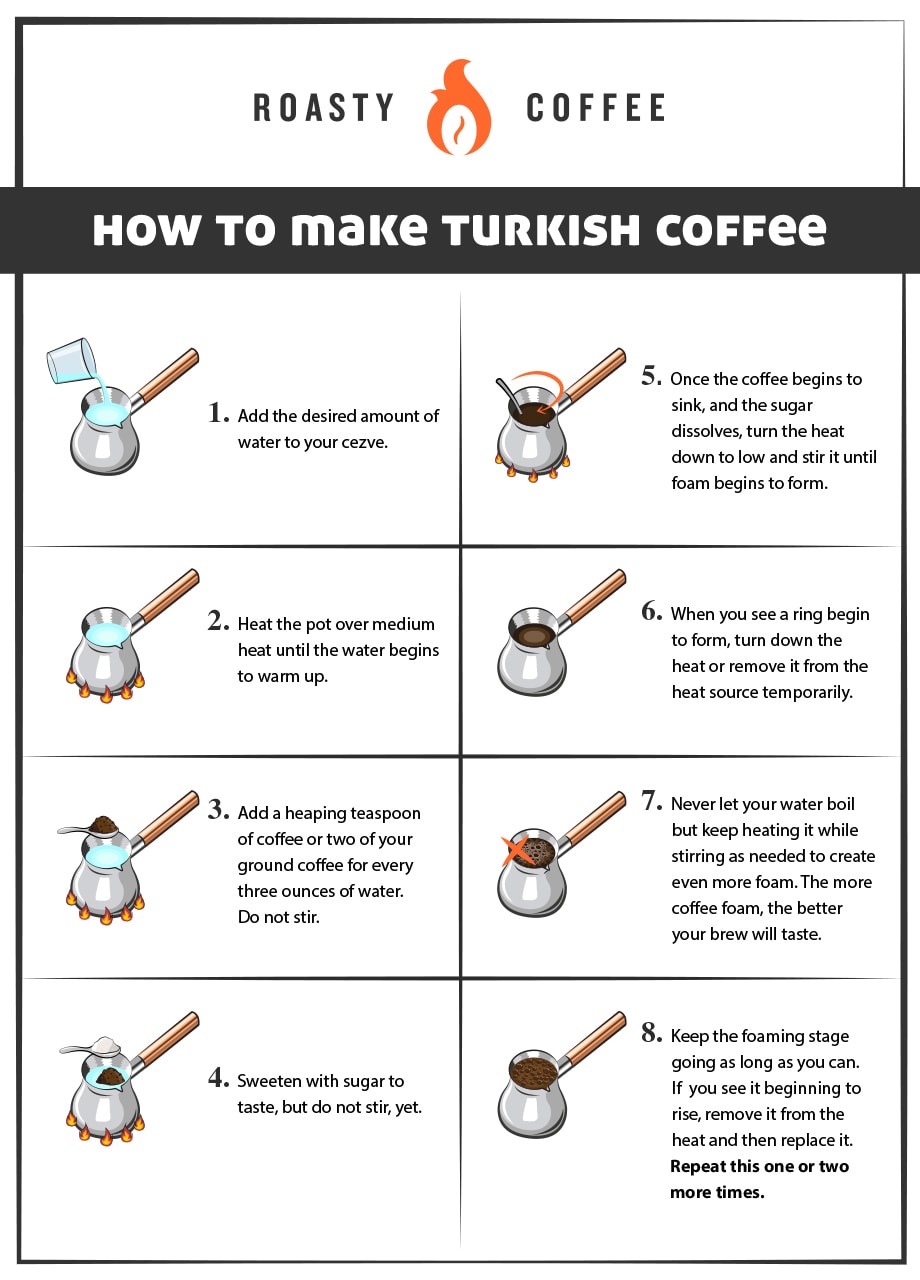
Have you ever wanted to make a delicious cup of Turkish coffee right in your own kitchen? It’s easier than you might think, but you will need a few supplies to do it right.
Read on to find out about this tasty drink that will soon become your favorite thing to sip on.
In the Beginning…
Turkish coffee originated in — you guessed it — Turkey, and today, the drink is considered an important part of Turkish culture. Over time, this brewing method has spread from its place of birth to many other areas including but not limited to Eastern Europe, North Africa, and the Middle East.
Carried to Istanbul in 1555 by Syrian traders, coffee grew in popularity and importance in Turkish culture. By the 17th century, the Turkish coffee brewing method became a central fixture in the country’s heritage, making its way into ceremonial roles like political meetings, marriage customs, and even fortune-telling practices in some parts of the world.
Nowadays, drinking Turkish coffee is still an essential social characteristic in Turkish society. It is often associated with hospitality and companionship and is one of the most beloved Turkish traditions.
Read Up on Turkish Coffee Reading
Yes, you read those previous paragraphs correctly: Turkish coffee can be used for fortune-telling! And no, not just some generic fortune that says, “Your day will be significantly better because you drank a good cup of coffee.” Besides, you already knew that would happen — that always happens when coffee is involved.
Turkish coffee readings are usually performed for religious purposes or in search of serious results. Still, it’s not uncommon for this practice to be done casually in the company of friends. No matter your reasons for taking up Turkish coffee reading, you’ve got to have an understanding of the symbols that show up in the grounds, intuition, and of course, lots of practice.
Turkish Coffee Traits
Turkish coffee is thick, bold, and rich. It’s an unfiltered coffee brewing method, meaning that the coffee is infused in the water, boiled, and the leftover grounds usually just settle at the bottom. This method of brewing and serving creates a strong coffee and is often served with water on the side so you can cleanse your palette before each savory sip.
Instead of adding sweetener after brewing the coffee, one unique characteristic of Turkish coffee is that it’s often brewed with sugar. It’s also custom that Turkish coffee is complemented by a sweet treat, with one famous example being Turkish Delight.
Thankfully, you don’t have to rely on specialty shops to try Turkish coffee. With just a few items, you can make it yourself in the comfort of your own home. It could quickly become a new favorite go-to coffee style for many who haven’t experienced its pleasant flavor.
What You Will Need
Sadly, you can’t take on this brew method with just any old coffee maker or espresso machine. You also need to ensure that your coffee grounds are extra fine, but the good news is that many roasters and coffee shops should be able to do this for you, but probably only by request.
If not, there are several affordable and durable coffee grinders on the market. If you make coffee regularly or already have a coffee grinder, you need to make sure that it grinds fine enough for Turkish coffee. The grounds need to be so fine that they’re almost powdery in texture.
In addition to the grinder, there are other items you will need. Below is a list of everything you should acquire before trying to brew Turkish coffee.
- Turkish Grinder
- Turkish Coffee Pot (called a cezve) — If you don’t have one of these at your disposal, a saucepan works fine, too.
- Water
- Sugar
- Spoon
- Finely Ground Coffee
The Breakdown on Beans
While most people who enjoy Turkish coffee tend to purchase Arabica beans, you can create Turkish coffee with any bean, whether Arabica or Robusta.
As far as the best roast goes, you want to start with a medium roast, as part of the process of creating Turkish coffee will involve roasting the beans even more. If you begin too dark, the coffee could end up too strong.
How to Make Turkish Coffee

Once you have gathered all of your supplies, it is time to get started with your very first Turkish coffee experience. All in all, this won’t take much longer than brewing a regular cup of coffee, but it will provide a coffee experience that’s not just unique but authentic and traditional as well.
- Add the desired amount of water to your cezve.
- Heat the pot over medium heat until the water begins to warm up.
- Add a heaping teaspoon of coffee or two (or a tablespoon, if you want something a bit stronger) of your ground coffee for every three ounces of water. Your coffee should be very finely ground. Do not stir.
- Sweeten with sugar to taste, but do not stir, yet. Depending on your preferences and what you have on hand, you can use granulated sugar or a cube of sugar.
- Once the coffee begins to sink, and the sugar dissolves, turn the heat down to low and stir it until foam begins to form.
- When you see a ring begin to form, turn down the heat or remove it from the heat source temporarily.
- Never let your water boil but keep heating it while stirring as needed to create even more foam. The more coffee foam, the better your brew will taste.
- Keep the foaming stage going as long as you can. If you see it beginning to rise, remove it from the heat and then replace it. Repeat this one or two more times.
Use fresh and fine coffee grinds, and manage your temperature. It’s important never to let the coffee come to a boil, this will overheat or overcook it, and you’ll have to start again. Try to create as much foam as you can by heating and stirring, and make sure to leave a little foam to enjoy on top once you pour it into your cup.
How To Drink Turkish Coffee
Once you’ve conquered this unique and traditional method of brewing, there’s also a particular way to drink it as well.
- Pour your traditional Turkish coffee and a separate glass of cold water.
- Wait for about one minute to allow the grounds to settle at the bottom of the coffee cup.
- Take a drink of H2O, as a sip of water will cleanse your palette.
- Sip the Turkish coffee slowly.
- Repeat steps 3 and 4 until finished.
Drinking Turkish coffee truly is an art form, and if done correctly, it can provide a coffee experience unlike any other.
Turkish coffee is an exotic beverage that many people, especially in the western hemisphere, have never had the opportunity to enjoy. While you may find it hard to find at your local coffee shop, you can easily make your own in the comfort of your home with the right equipment.
No Time for Turkish?
There are other options to get access to Turkish coffee for those who don’t have time to grind their coffee at home.
The bad news is that there aren’t many coffee shops in the United States who explicitly serve Turkish coffee, but some should be able to create it upon request.
The good news is, there are several delicious Turkish coffee options online. Some of our favorite choices on the market right now include Kuru Kahveci Mehmet Efendi, Nuri Toplar, and Elite Turkish Coffee. These blends have rich, robust flavors that will create an enjoyable coffee experience for both Turkish coffee experts and beginners.
Top Tools For Turkish Coffee
We’ve compiled a list of the greatest tools to make Turkish coffee on the market right now. Here are some sturdy, dependable, and efficient tools used to brew a delicious cup of Turkish coffee.
Bosphorus 16 Piece Turkish Coffee Set
If you’re going to put in the work of making traditional Turkish coffee, you’ll need the right materials on hand. And besides, you not only want your beverage to taste great; you want it to look great when it’s served as well! For that reason, we recommend investing in a solid Turkish coffee kit, like this one from Bosphorus.
Complete with a stamped copper coffee pot, two lidded bowls perfect for holding sugar or Turkish Delight, and two porcelain cups, saucers, cup holders, and lids. Set all of this up on the beautifully engraved serving tray, and your Turkish coffee presentation is sure to impress anyone who lays eyes on it.
Kuprum Hand-Hammered Turkish Coffee Pot
If you want to make Turkish coffee at home but don’t want to purchase an entire Turkish coffee kit, check out this sturdy and reliable option from Kuprum. It’s perfect for the Turkish coffee brewing beginner.
Kuprum’s hand-hammered Turkish coffee pot is easy to use, easy to clean, and modeled after traditional Turkish pots, making it authentic to the Turkish brewing experience. Because it’s made of solid copper, it heats your coffee quickly and evenly, so you won’t have to wait very long to enjoy a piping hot cup of joe.
Crystalia Manual Coffee Grinder
If you’re trying to make your Turkish coffee experience as authentic as possible, you’ll need a good manual coffee grinder, like this offering from Crystalia. And since there’s no need to plug anything in, you can bring this grinding tool along with you on your next camping trip if you hope to enjoy Turkish coffee in the great outdoors.
The compact grinder fits easily in your pack when you’re on the go and neatly in a drawer when it’s not in use, and its metal burrs ensure your joe is a consistent size once ground. Turn the wheel on the bottom of the tool to adjust the size of your coffee grounds, and once you’ve ground enough grams of coffee for your morning cup, simply wipe the device clean with a dry cloth.
Frequently Asked Questions
What’s a cezve?
A cezve often called an ibrik in other places, is a Turkish coffee maker. It’s a small pot usually made of copper or brass. Sometimes, you’ll even find one made of more precious metals, like silver or gold. The little coffee pot typically has a long handle and a special lip designed explicitly for pouring Turkish coffee.
Though you can throw a saucepan atop your heat source and make decent Turkish coffee, a cezve is the ideal tool for getting the job done because its efficient structure enables the coffee to blend into the water well. It also helps you preserve as much coffee foam as possible when you pour the joe into your cup, which is extra important since the foam on top of the coffee is an important trait of Turkish coffee.
What do I do if I don’t have a cezve?
No worries if you don’t have a cezve nearby. Though the cezve vessel is best for brewing Turkish coffee, you can still make it with other containers; you’ll just have to tweak the method a bit. The steps are the same, but you’ll have to keep a closer eye on the temperature fluctuation as the coffee is heating.
You should also note that there won’t be as much foam if you’re using a larger pot, so we recommend using the smallest pot you have.
What if I am making Turkish coffee for multiple people?
We’d love to tell you there is an easy way to make a batch of this coffee mixture large enough to serve a crowd and please people with different sugar preferences. But unfortunately, there isn’t. If you intend to sip this stuff in the company of coffee lovers who want varying degrees of sweetness, the best thing to do is make individual cups of coffee for everyone.
Can I add anything other than sugar to my Turkish coffee?
Technically, you can add anything to your coffee cup; no one’s stopping you from drinking your java your way. But when it comes to a traditional Turkish coffee recipe, adding things like milk or creamer is usually frowned upon. This is because adding anything other than a few teaspoons of sugar might alter the classic flavor of the drink.
Can I drink Turkish coffee every day?
You can enjoy this coffee treat daily, but just as with any caffeinated beverage, you should limit your intake. Breaking out the traditional cezve for brewing more than three times a day can cause heart rhythm disorders, which is why cardiovascular patients should exercise extreme caution when sipping it or caffeinated coffee beverages in general.
How strong is it?
Turkish coffee can taste very strong due to the unfiltered brewing method of placing the coffee in the water. This is another excellent reason why it’s commonly served with a glass of water. It’s a traditional, delicacy drink, and its powerful, rich flavor is meant to be sipped and enjoyed.
As far as caffeine content goes, it’s definitely more potent than your average drip coffee but not as strong as a shot of espresso. This drink is more concerned about flair and flavor than packing a hefty punch of caffeine.
Recommended: Turkish Coffee Vs. Espresso
Is it supposed to be gritty?
Since the grounds settle at the bottom of the cup, it’s normal for your drink to be slightly gritty. This is why it’s important to make sure that, if you’re grinding your coffee beans yourself, you grind them to the finest setting possible.
If you find your Turkish coffee is a little too gritty — so much so that it’s uncomfortable to drink — you should probably adjust your grinder settings before you attempt to brew Turkish coffee again.
Does Starbucks sell Turkish coffee?
It’s not unusual for you to hop in the car and head to your nearest Starbucks location when the coffee craving strikes. But unfortunately, if that craving demands a cup of joe made Turkish-style, you won’t find much satisfaction at the Seattle-born franchise.
Starbucks Coffee doesn’t sell cups of Turkish coffee, but you can always purchase a bag of the brand’s whole bean coffee, grind it yourself, and use it to make the drink at home — it’ll taste just as good as it would have if you purchased it from the coffee shop, and you didn’t have to wait in a long line to get it!
Can I make Turkish coffee in a French press?
No, you can’t make authentic Turkish coffee in a French press. Boiling is an essential part of the Turkish coffee brewing process, and you can’t boil coffee in a French press.
How is Turkish coffee different from Arabic coffee?
These two drinks are very similar in the sense that they’re both served black — free of milk or creamer — and are consumed with the finely-ground coffee beans in the bottom of the cup. However, the major difference between these two drinks is that Arabic coffee almost always contains cardamom and no sugar. In contrast, Turkish coffee is usually sweetened with sugar and has no cardamom.
Of course, this distinction doesn’t always apply; sometimes, drinkers sweeten Arabic coffee with a few cubes of sugar, and many coffee lovers spice up their Turkish coffee with a sprinkle of cardamom these days.
Where can I find Turkish coffee cups?
Believe it or not, a Turkish coffee cup, called a fincan, isn’t tough to find. You can easily find one on sites like Amazon or Etsy.
You don’t necessarily need one of these special little espresso cups to enjoy Turkish coffee, but we recommend them; the porcelain from which they’re made works wonders for keeping your drink hot as you sip it.
Wrapping Up
Turkish coffee is a unique experience, from the moment you brew it until you take the last sip — even after, if you decide to take up coffee reading.
If given the opportunity to try Turkish coffee, do it; this treat will be entertaining to make and enjoyable to drink. We wouldn’t be surprised if it became your new favorite thing to make at home.
Happy Caffeinating!

Turkish Coffee
Turkish coffee is thick, bold, and rich. It's an unfiltered coffee brewing method, meaning that the coffee is infused in the water, boiled, and the leftover grounds usually just settle at the bottom. Try it out!
Ingredients
- Turkish Grinder
- Turkish Coffee Pot
- Water
- Sugar
- Spoon
- Finely Ground Coffee
Instructions
- Add the desired amount of water to your cezve.
- Heat the pot over medium heat until the water begins to warm up.
- Add a heaping teaspoon of coffee or two of your ground coffee for every three ounces of water. Do not stir.
- Sweeten with sugar to taste, but do not stir, yet.
- Once the coffee begins to sink, and the sugar dissolves, turn the heat down to low and stir it until foam begins to form.
- When you see a ring begin to form, turn down the heat or remove it from the heat source temporarily.
- Keep the foaming stage going as long as you can. If you see it beginning to rise, remove it from the heat and then replace it.










